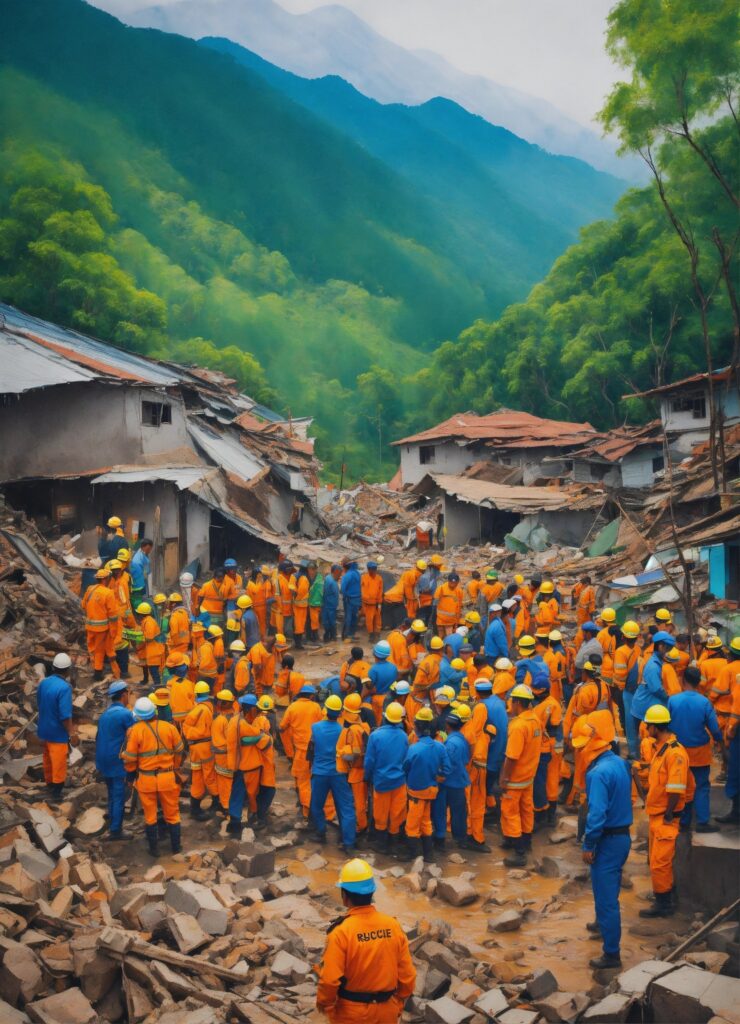Great Health Great Fitness
“Earthquakes: Rumbling Horizons and Their Devastating Effects on Human Health”
In the wake of seismic upheavals, humanity faces a dual challenge: the physical devastation wrought by earthquakes and the profound impacts on human health. As the ground trembles and structures crumble, the reverberations are felt far beyond the shattered buildings. Lives are upended, communities displaced, and health systems strained to their limits. In this turbulent landscape, the urgent need for preparedness, response, and resilience becomes starkly evident. Join us as we explore the seismic symphony of challenges and opportunities in safeguarding human health amidst rumbling horizons.

Introduction
Earthquakes are among the most destructive natural disasters, capable of causing widespread devastation and loss of life. These seismic events result from the sudden release of energy in the Earth’s crust, leading to ground shaking, surface rupture, and in some cases, tsunamis. While the immediate impact of earthquakes is often evident in the physical damage to infrastructure and loss of life, their effects on human health can be far-reaching and long-lasting.
Understanding the impact of earthquakes on human health is essential for effective disaster preparedness, response, and recovery efforts. From physical injuries and trauma to mental health challenges and long-term health consequences, earthquakes can have profound effects on individuals, communities, and healthcare systems. Vulnerable populations, such as children, the elderly, and those living in poverty, are often disproportionately affected, highlighting the need for targeted interventions and support.
In this paper, we will explore the various ways in which earthquakes can impact human health, from immediate injuries and psychological trauma to long-term health effects and environmental risks. We will examine the role of public health agencies, healthcare providers, and international organizations in responding to earthquake disasters and mitigating their health impacts. Through case studies, examples, and analysis, we will uncover lessons learned from past earthquakes and identify strategies for building more resilient communities and healthcare systems capable of responding effectively to future seismic events.
II. Understanding Earthquakes
- Definition and causes of earthquakes: Discuss the geological processes that lead to earthquakes, including tectonic plate movements, fault lines, and seismic activity.
- Types of seismic waves and their effects: Explain the different types of seismic waves (e.g., P-waves, S-waves, surface waves) and how they contribute to the shaking and damage during an earthquake.
- Frequency and distribution of earthquakes globally: Provide statistics on the frequency of earthquakes worldwide, highlighting regions prone to seismic activity (e.g., Pacific Ring of Fire, fault lines in California).
III. Immediate Health Impacts of Earthquakes

- Physical injuries: Explore common injuries sustained during earthquakes, such as fractures, lacerations, and head injuries, and discuss the challenges in providing immediate medical care amid widespread destruction.
- Psychological effects: Detail the psychological toll of earthquakes, including symptoms of PTSD, anxiety disorders, and depression, and discuss the importance of mental health support in the aftermath of a disaster.
- Immediate medical needs and challenges in disaster response: Describe the logistical challenges faced by healthcare providers in delivering emergency medical care, including triage, resource allocation, and coordination of rescue efforts.
IV. Long-Term Health Effects
- Chronic health conditions arising from injuries: Discuss the long-term physical consequences of earthquake-related injuries, such as chronic pain, disability, and complications from untreated wounds.
- Mental health consequences: Explore the enduring psychological impact of earthquakes on survivors, caregivers, and communities, including factors that contribute to resilience and recovery.
- Environmental health risks: Examine the environmental hazards triggered by earthquakes, such as contamination of water supplies, exposure to hazardous materials, and the spread of infectious diseases in crowded shelters.
V. Vulnerable Populations
- Children and elderly: Discuss the unique vulnerabilities of children and older adults in earthquake disasters, including their increased risk of injury, trauma, and separation from caregivers.
- Displaced populations: Highlight the health risks faced by displaced populations, including inadequate shelter, limited access to healthcare services, and heightened vulnerability to exploitation and abuse.
- Socioeconomic disparities in health outcomes post-earthquake: Analyze the impact of socioeconomic factors, such as poverty, education level, and access to healthcare, on disparities in health outcomes following an earthquake.
VI. Public Health Response and Preparedness

- Importance of disaster preparedness and mitigation measures: Stress the importance of proactive measures, such as emergency preparedness planning, infrastructure improvements, and public education campaigns, in reducing the impact of earthquakes on human health.
- Role of public health agencies and international organizations: Outline the responsibilities of public health agencies, NGOs, and international bodies in coordinating disaster response efforts, providing medical supplies and personnel, and supporting affected communities.
- Case studies of successful disaster response and recovery efforts: Highlight examples of effective disaster response and recovery efforts, including lessons learned and best practices for future preparedness and resilience-building.
VII. Mitigation Strategies
- Building codes and infrastructure resilience: Discuss the importance of enforcing strict building codes and standards to enhance structural resilience against earthquakes, including retrofitting existing buildings and infrastructure to withstand seismic forces.
- Early warning systems and community preparedness initiatives: Explain the role of early warning systems in providing timely alerts to at-risk populations, as well as community-based preparedness initiatives, such as earthquake drills, evacuation plans, and first aid training.
- Education and training for healthcare professionals and the public: Emphasize the need for ongoing education and training programs to equip healthcare professionals with the skills and knowledge necessary to respond effectively to earthquake disasters, as well as to empower the public to take proactive measures to protect their health and safety.
VIII. Case Studies and Examples
Notable Earthquakes and Their Health Impacts
- 2010 Haiti Earthquake:
- The magnitude 7.0 earthquake that struck Haiti on January 12, 2010, caused catastrophic damage to the capital city of Port-au-Prince and surrounding areas.
- Health impacts: The earthquake resulted in an estimated 230,000 deaths and left over 300,000 people injured, overwhelming Haiti’s already fragile healthcare infrastructure. Many hospitals and medical facilities were destroyed or severely damaged, leading to shortages of medical supplies, personnel, and treatment options.
- Challenges: Limited access to medical care, sanitation, and clean water exacerbated the spread of infectious diseases such as cholera, resulting in a widespread outbreak that affected hundreds of thousands of people.
- Lessons learned: The Haiti earthquake highlighted the importance of international collaboration and coordination in disaster response efforts. It underscored the need for pre-positioning of medical supplies, rapid deployment of medical teams, and the establishment of field hospitals to provide emergency medical care in the aftermath of a disaster.
- 2015 Nepal Earthquake:
- The magnitude 7.8 earthquake that struck Nepal on April 25, 2015, and its subsequent aftershocks caused widespread destruction across the country, including the capital city of Kathmandu and rural mountainous regions.
- Health impacts: The earthquake resulted in over 9,000 deaths and tens of thousands of injuries, with many survivors suffering from crush injuries, fractures, and trauma. Access to medical care was limited, particularly in remote areas, leading to delays in treatment and increased mortality rates.
- Challenges: The earthquake triggered landslides and avalanches, hampering rescue and relief efforts and isolating communities from essential services. Inadequate sanitation and hygiene facilities increased the risk of infectious diseases, while overcrowded makeshift shelters heightened the risk of respiratory infections and other illnesses.
- Lessons learned: The Nepal earthquake highlighted the importance of community-based disaster preparedness and response initiatives. It emphasized the need for strengthening healthcare infrastructure, training local healthcare workers in emergency medical care, and integrating mental health support into post-disaster recovery efforts.
- 2011 Tohoku Earthquake and Tsunami (Japan):
- The magnitude 9.0 earthquake that struck off the coast of Japan on March 11, 2011, triggered a powerful tsunami that devastated coastal communities in the Tohoku region, causing widespread destruction and loss of life.
- Health impacts: The earthquake and tsunami resulted in over 15,000 deaths and tens of thousands of injuries, with many survivors suffering from traumatic injuries, hypothermia, and drowning-related injuries. The nuclear accident at the Fukushima Daiichi nuclear power plant further compounded health concerns, leading to radiation exposure and psychological distress among evacuees.
- Challenges: The scale and complexity of the disaster overwhelmed local healthcare systems and emergency response capabilities, leading to delays in medical treatment and shortages of medical supplies. Concerns about radiation exposure and contamination of food and water sources heightened anxiety and uncertainty among affected populations.
- Lessons learned: The Tohoku earthquake and tsunami highlighted the importance of disaster resilience and preparedness in mitigating the impact of complex emergencies. It underscored the need for comprehensive disaster planning, effective communication strategies, and coordination among multiple agencies and stakeholders to ensure a timely and coordinated response to large-scale disasters.
Additional Insights from Past Disasters:
- Lessons in Disaster Preparedness:
- Adequate infrastructure: The importance of enforcing building codes and standards to enhance structural resilience and minimize casualties during earthquakes.
- Early warning systems: Investing in early warning systems and public education campaigns to alert at-risk populations and facilitate timely evacuation and emergency response.
- Community resilience: Strengthening community-based disaster preparedness initiatives, including training local volunteers, establishing evacuation routes, and stockpiling emergency supplies.
- Improving Disaster Response and Recovery Efforts:
- Coordinated response: Enhancing coordination and communication among government agencies, non-governmental organizations, and international partners to ensure a comprehensive and timely response to disasters.
- Capacity building: Investing in training and capacity building for healthcare professionals, emergency responders, and community leaders to improve preparedness and response capabilities.
- Long-term recovery planning: Integrating health considerations into long-term recovery planning efforts, including rebuilding infrastructure, restoring essential services, and addressing the mental health and psychosocial needs of affected populations.
By analyzing the health impacts of notable earthquakes and identifying lessons learned from past disasters, policymakers, healthcare providers, and disaster management agencies can better prepare for future seismic events and mitigate their impact on human health.
IX. Future Challenges and Opportunities
- Emerging technologies for earthquake prediction and monitoring: Explore recent advancements in earthquake forecasting, early warning systems, and seismic monitoring technologies, as well as the potential benefits and limitations of these innovations in mitigating the health impacts of earthquakes.
- Addressing the intersection of climate change and seismic activity: Examine the potential effects of climate change on seismic activity, including changes in precipitation patterns, sea level rise, and the destabilization of geological formations, and discuss strategies for adapting to these challenges and building resilience.
- Building resilient communities and healthcare systems: Propose recommendations for building more resilient communities and healthcare systems capable of responding effectively to earthquake disasters, including investments in infrastructure, healthcare workforce development, and community-based disaster preparedness initiatives.
X. Conclusion
- Recap of key findings and insights: Summarize the main points discussed in the paper, highlighting the multifaceted impact of earthquakes on human health and the importance of comprehensive preparedness and mitigation strategies.
- Call to action for prioritizing earthquake preparedness and public health initiatives: Advocate for increased investment in earthquake preparedness, response, and recovery efforts at the local, national, and international levels, emphasizing the importance of collaboration and coordination among stakeholders.
- Closing thoughts on the importance of understanding and mitigating the health impacts of earthquakes: Reflect on the broader significance of studying the health effects of earthquakes in promoting human well-being, resilience, and sustainable development in earthquake-prone regions worldwide. For More Information you can check our blogs “Understanding the Causes of Stomach Worm Infections: A Comprehensive Overview”.
